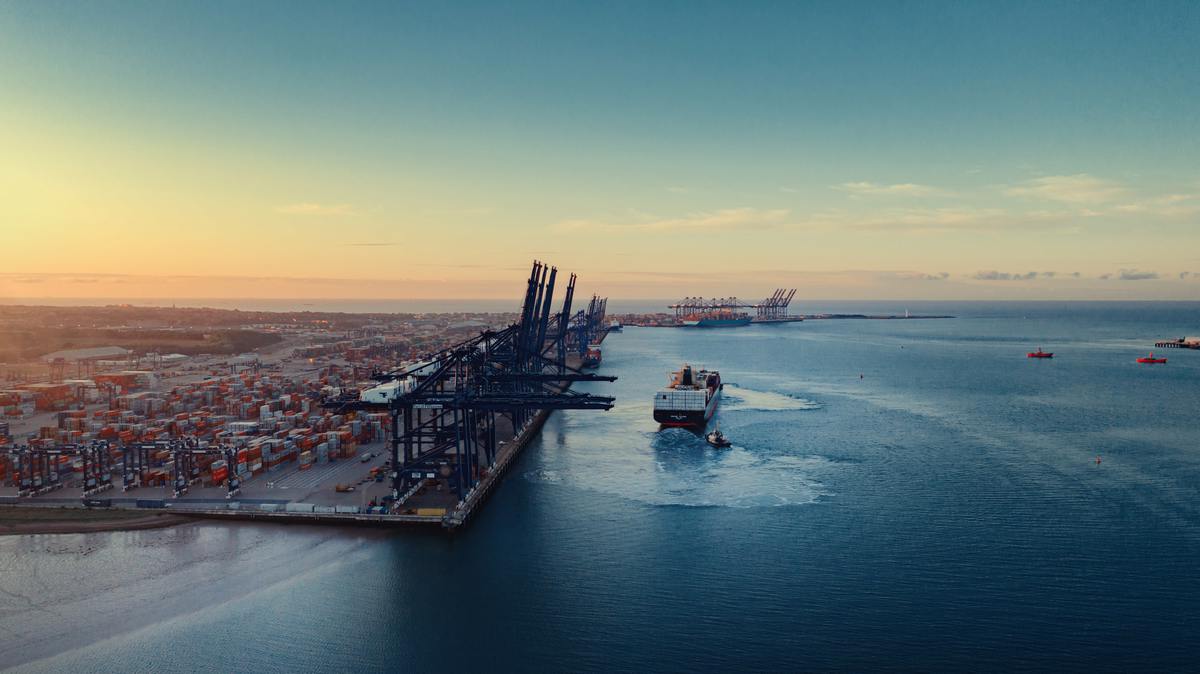UK needs basket of shipping regulations to reach net zero by 2050 – T&E
The UK should introduce energy efficiency measures, a GHG intensity standard and a 6% RFNBO target for all vessels calling at UK ports by 2030, a Transport & Environment (T&E) report recommends.
 PHOTO: Aerial view of Port of Felixstowe, a container port in Suffolk, England. Getty Images
PHOTO: Aerial view of Port of Felixstowe, a container port in Suffolk, England. Getty Images
As part of its Climate Change Act of 2008, the UK committed to reducing 100% greenhouse gas (GHG) emissions by 2050, compared to 1990 levels. To achieve this goal, the government sets a 5-year action roadmap called the carbon budget delivery plan.
The sixth carbon budget was legislated by the UK government in June 2021. It sets the carbon emission budget of 965 million mt of carbon dioxide equivalent (mtCO2eq) between 2033-2037 for the overall UK economy. This budget requires the UK to cut its overall GHG emissions by 78% by 2035, compared to 1990 levels. Notably, this budget marks the first time shipping emissions were included.
“The Government’s [sixth] Carbon Budget Delivery Plan pathway requires emissions from domestic shipping and the UK’s share of international shipping to fall by around 22% by 2035 on 2019 levels,” the Climate Change Committee wrote in a progress report on emission reduction submitted to the UK Parliament in June 2023.
The Climate Change Committee (CCC) is a non-departmental public agency in the UK established under the UK’s Climate Change Act of 2008.
However, despite the urgent need to eliminate these emissions, the UK has ‘no credible policies’ to reduce shipping emissions to meet the carbon budget, the CCC report argued. T&E supports this argument by pointing out that "there are no commercial or effective regulatory drivers in the UK. Fossil marine fuels are untaxed and their emissions are uncharged."
Need for urgent policy action in the UK
The UK's shipping sector recorded 12.2 million mtCO2eq of GHG emissions in 2022, according to the CCC's report. This is 12% below 2019 levels, the report said. To reach the 22% goal, shipping emissions must be reduced even further.
The CCC has called on the government to urgently implement policies to reduce shipping emissions as long as the goal remains in sight.
It advised that carbon intensity from domestic vessels must improve by 44% and international vessels by 31%. At least 42% of domestic and 28% of international vessels should be powered by low-carbon fuels like ammonia, methanol and hydrogen by 2035.
“The Low-Carbon Fuels Strategy should set out the role of low- and zero-carbon fuels for the shipping sector in addition to the Government providing support and incentives to drive private-sector investment in low-carbon maritime fuels,” the CCC report to UK Parliament noted.
T&E echoes the CCC's position and urges the UK government to implement a “demand-generating regulatory framework” to drive investment in zero-emission fuels and technologies. Based on the CCC's guidance, T&E recommends the following legal measures to regulate shipping emissions for all vessels calling at UK ports:
- A well-to-wake (WTW) energy GHG intensity standard of 65.9 grams of CO2 equivalent per megajoule of fuel (gCO2eq/MJ) in 2030. It should decrease to 5.5 gCO2e/MJ in 2040 and zero in 2050 to gradually increase the use of low- and zero-emission marine fuels.
- At least 6% of all fuel used onboard vessels by 2030 should be green hydrogen and derivative fuels (RFNBOs), such as green ammonia and e-methanol. The RFNBO target should be higher than the UK's 1% target assumed in the sixth carbon budget and FuelEU Maritime's RFNBO target for 2030.
- The RFNBO target should increase to 42% for domestic and 28% for international vessels by 2035, in line with the CCC’s recommendation.
- Energy efficiency measures mandating all ships calling at UK ports to meet the “standard required” for CII’s ‘A’ rating.
The International Maritime Organisation's (IMO) CII regulation measures how efficiently a ship transports goods or passengers. It is expressed in grams of CO2 emitted per mt of cargo and nautical mile. The ship is then rated every year from A to E (A being the highest). Rating criteria will become stricter by 2030.
A legal analysis commissioned by T&E shows that "the UK already has the necessary primary legislative powers to obligate all vessels calling at UK ports to comply with the above measures”, it says.
“The combination of regulatory measures recommended here would permit a spectrum of energy technology options (initially) to progressively reduce shipping emissions, but also target the large-scale use of RFNBOs and electricity as soon as possible. This is likely to be more effective than any single measure,” T&E concludes.
By Konica Bhatt
Please get in touch with comments or additional info to news@engine.online






